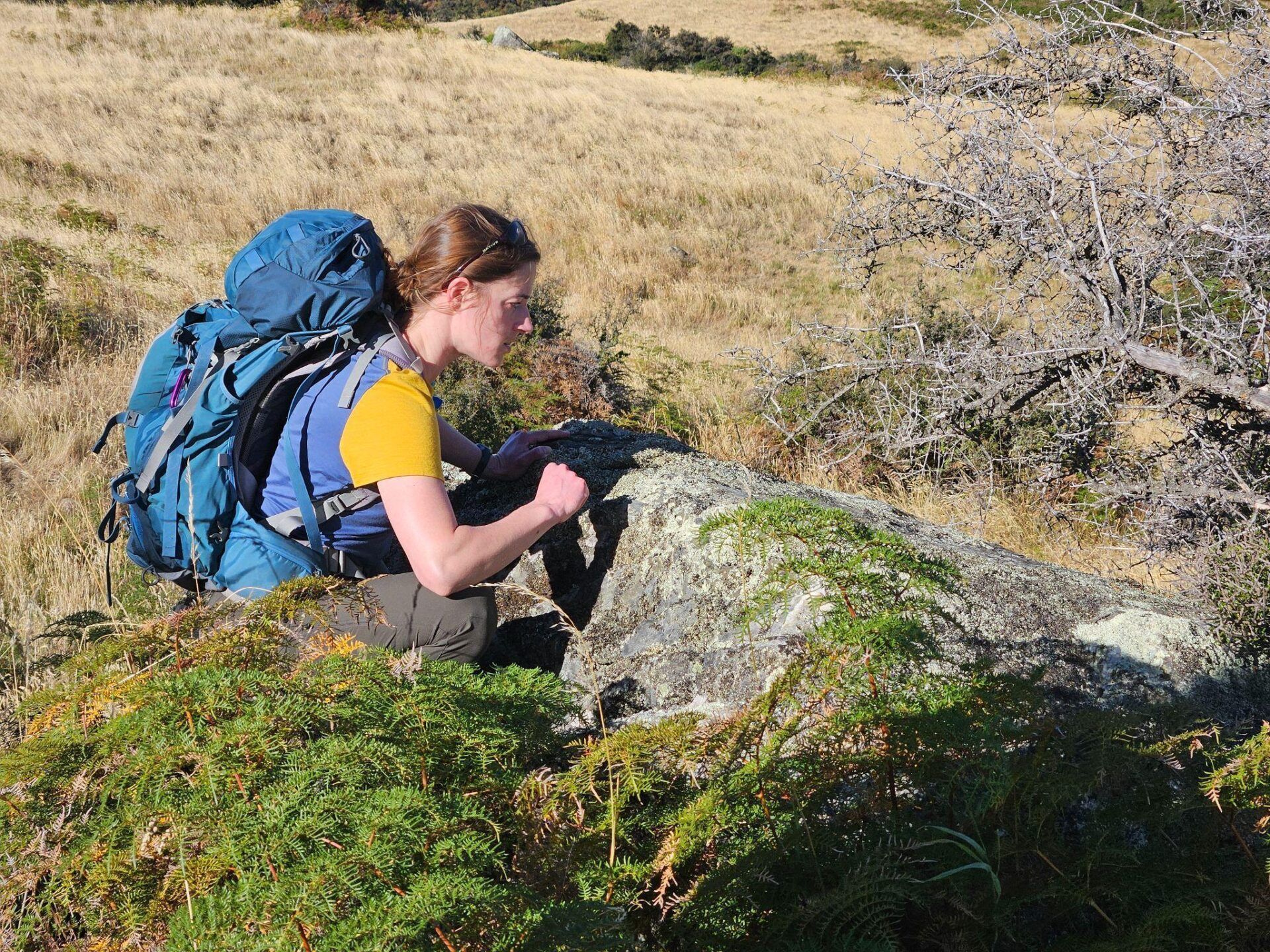
‘The fly in the Milanković ointment’
With new data, researchers attempt to overturn long-held theory on ice ages and climate change
By Louise Kim
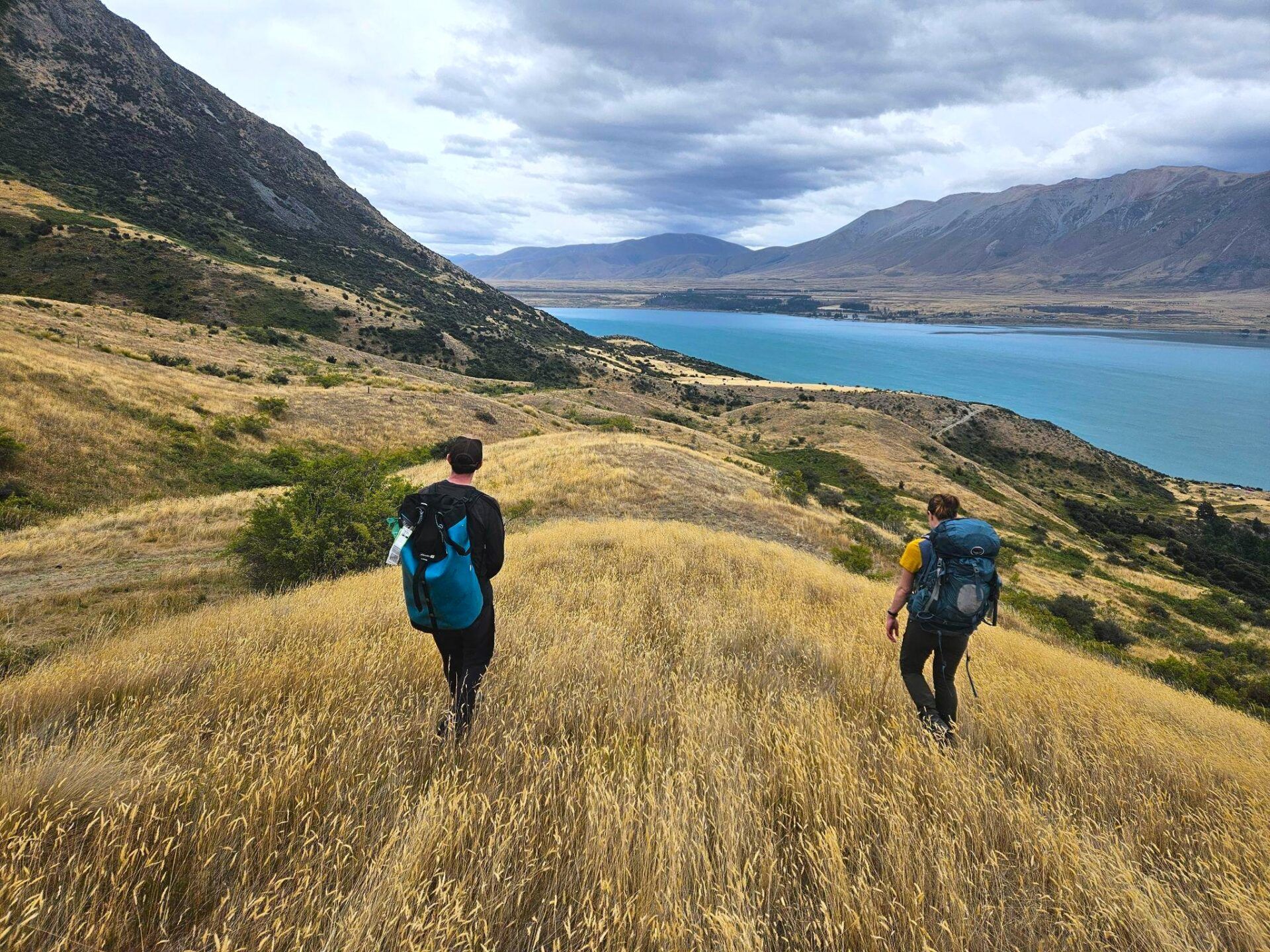

Editor’s note: This article was produced in partnership with Northwestern University’s Medill School of Journalism, Media, Integrated Marketing Communications.
July 22, 2024
The cows watched us as we trekked through the tall grass of the Ruataniwha Conservation Park in New Zealand. Tails swished in the warm summer air, and their heads slowly turned in sync to follow our movements. Ahead of me, University of Maine graduate students Tricia Collins and Alexzander Roman navigated the rugged terrain with ease, pausing occasionally to scout the area. At times, they would get excited over a faraway view, only to realize that what they saw in the distance was a lone cow that had roamed from the herd.
“The age-old question: Is it a bovine or a boulder?” Roman said.
Collins and Roman were hunting, not for cows, but for large rocks that had been deposited by glaciers during the Last Glacial Period—more familiar to us as the last ice age. These boulders, as unassuming as they appear, hold the key to understanding what abrupt climate change looked like in the past and what it could mean for the future.
The planet is warming at an unprecedented rate. During the past 12 months, the world has surpassed the 1.5 degrees Celsius threshold beyond which, scientists have warned, lies more extreme weather events and losses calculated in skyrocketing dollar amounts. And in human lives.
The Last Glacial Period reached its maximum coverage about 20,000 years ago and left behind a lot of clues as to how glaciers advanced and retreated. But some of the mechanisms behind ice ages remain shrouded in mystery—like what causes them, for one thing.
“The biggest questions in Earth science are still the biggest questions today,” said Aaron Putnam, an associate professor at the University of Maine, and Collins’ advisor. If scientists can piece together the atmospheric, oceanic, and planetary forces that trigger ice ages, they will have a better understanding of how these forces play out today.
Putnam, his students, and George Denton, a renowned geologist who pioneered this area of climate research in New Zealand, think they’ve cracked the code to ice age triggers—a problem that has puzzled scientists since the 19th century. It’s important, timely work because figuring out the mechanisms behind the last abrupt climate shift could help us predict and understand how climate change manifests now.
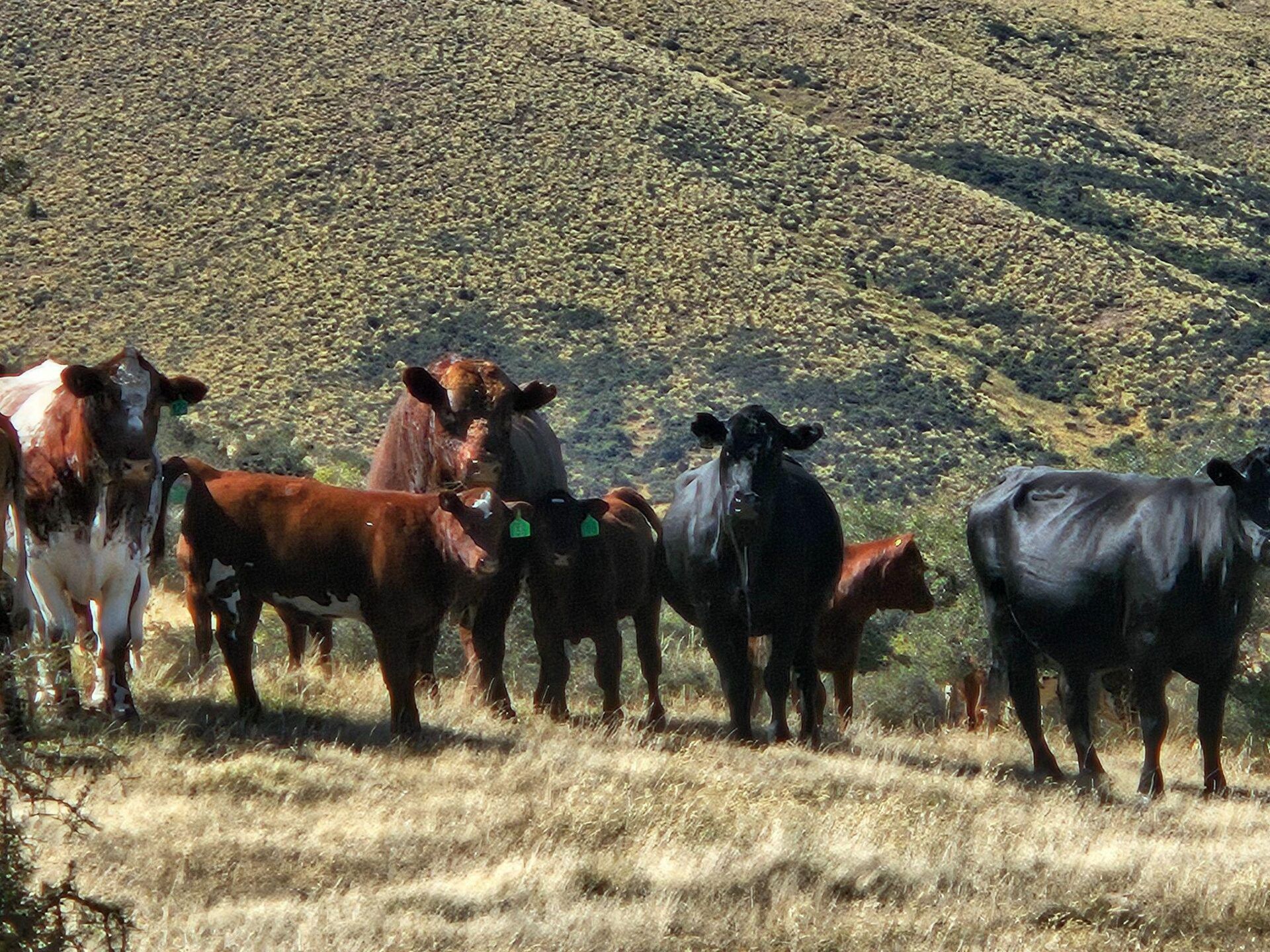
The ice age problem
In 1911, Serbian mathematician and astronomer Milutin Milanković set out to uncover the cause of ice ages. He spent decades working on this problem, even as German-led forces occupied his home and sent him to prison during World War II. He made every calculation by hand. In 1941, he published the Canon of Insolation and the Ice-Age Problem, a hefty 600-page book documenting the tables, charts, and equations he used to show what are now called Milanković cycles.
Milanković explained that three cycles related to Earth’s orbit affect insolation, or the amount of energy the planet collects from the sun. The cycles involve the shape of Earth’s orbit (eccentricity), the tilt of the Earth’s axis toward or away from the sun (obliquity, which is responsible for the seasons), and the movement of Earth’s rotational axis (precession). All three of these cycles determine where and how much insolation reaches the planet.
Milanković theorized that over thousands of years, the variations in these cycles and the resulting insolation triggered long-term climate events like ice ages. He also thought that changes in radiation at certain latitudes during certain seasons played an even larger role in influencing ice masses. He concluded that changes in the intensity of solar forcing during summer in the northern latitudes, specifically at 65 degrees north at the foot of the Arctic Circle, drive glacial cycles. Simply put, over thousands of years, cooler summers due to lower levels of insolation would reduce snowmelt and trigger an ice age. His calculations implied ice ages are globally asynchronous—meaning in the Northern and Southern Hemispheres they are in antiphase to each other, just as the seasons are.
Periodic changes to Earth's orbital motion, known as Milanković cycles, affect the amount of sunlight and therefore, energy, that the planet absorbs from the Sun. These cycles help explain long-term changes in Earth’s climate. (Animation by NASA/JPL-Caltech)
This seems to make sense. How could ice ages be synchronous if the hemispheres receive different amounts of sunlight at different times of year—when it’s summer in July in the United States, but winter in Argentina? Later geological discoveries yielded results that correlated with Milanković’s findings. In 1976, researchers used ocean sediment cores to calculate temperature change from the past 500,000 years. They found that variations in climate were associated with changes in Earth’s position relative to the Sun. This helped cement Milanković’s ideas as the dominant theory behind ice ages.
“I don’t think anyone questions it,” said Denton, a professor at the University of Maine and one of Putnam’s mentors.
Back at the holiday park where we were staying, Denton held up a copy of the Canon of Insolation and the Ice-Age Problem. He remarked that the book was difficult to find; he thinks that most scientists who reference it haven’t even read it. He had. Cover to cover.
The first significant challenge to Milanković’s theory came from glaciologist John Mercer in the 1980s and became known as Mercer’s Paradox.
By dating boulders, Mercer found that glacier systems in the Northern and Southern Hemispheres reached their maximum extent and terminated around the same time, despite differences in solar intensity at different times of the year. That contradicted Milanković's conclusions in the Canon of Insolation and the Ice-Age Problem. But Mercer’s ideas never made it into the mainstream, as Milanković’s had. And there’s always been a problem with describing a mechanism for any of these theories. Perhaps Mercer’s observations were right, but he could not explain them.
Denton and his students were working to answer some of the questions Mercer could not.
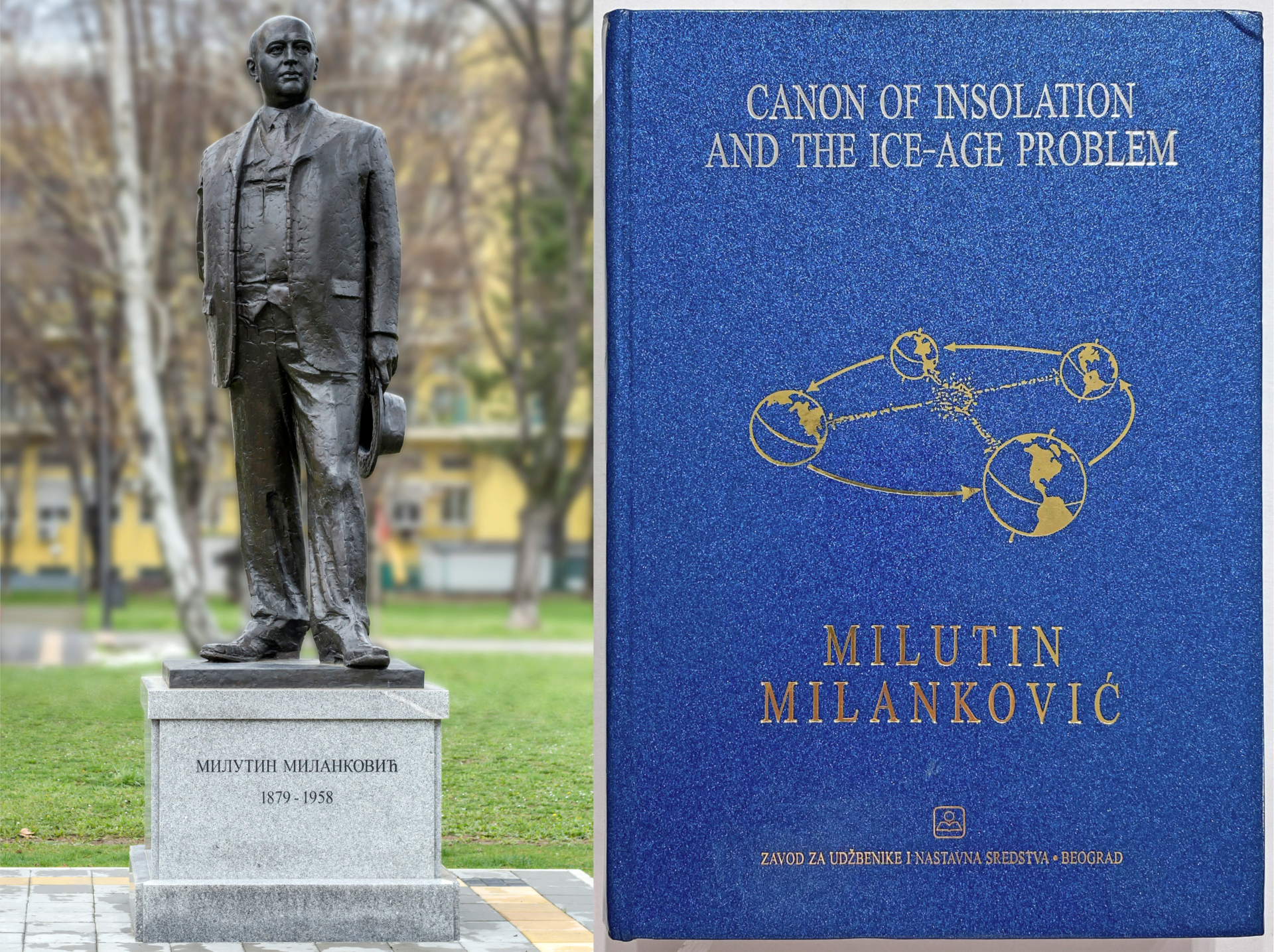
Records of the past
Glaciers form over thousands of years of ice and snow accumulation. During a glacial advance, a glacier moves under the influence of its own weight and gravity, slowly flowing down the valley like a frozen river. As this river of ice “flows” forward, its icy fists grab nearby dirt and rocks, from pebbles to huge boulders, and carry them downstream. During a glacial retreat, the ice melts, leaving this sediment behind and sometimes forming ridge-like landforms called moraines.
Researchers can get an approximate age of a moraine by dating enough of the boulders that lie on it to acquire a statistical mean. The dating takes advantage of one atomic process: During glacial advance, ice covers boulders, shielding them from cosmic rays and preventing the production of beryllium-10, an isotope formed as rays collide with quartz contained in the rock. Typically, researchers look for boulders that are smooth and rounded, signs that previous buildup of beryllium-10 was scoured away when a glacier devoured it.
Located in the Canterbury region of New Zealand, on the western side of the Ben Ohau mountain range, the Ruataniwha Conservation Park is characterized by tussocky hillsides and winding trails. Boulder-strewn ridges and meltwater channels where water once flowed are prime examples of how glaciers shaped the landscape. “New Zealand, in a lot of ways, makes our job easier because the landscape is so young, the mountains are so young and so actively eroding,” Collins said. Even without a large amount of time in the glacier, erosion removes previous buildup of the isotope.
Eventually, as it melts and retreats, a glacier drops boulders onto the Earth’s surface. What happens is like starting a stopwatch. As soon as the ice melts and cosmic rays can reach the rock, beryllium-10 production begins. The more beryllium-10, the longer the time span since the glacier deposited the boulder. And the time span can be calculated, because beryllium-10 accumulates in predictable amounts year after year.
In New Zealand, Collins is adding to the existing body of research on the Ben Ohau Range and the glaciers that once covered this area by tracking the termination of ice in a valley near Lake Ohau. Dating these moraines will give her a clearer picture of what the end of the last ice age looked like and allow her to compare her results with studies done in the Northern Hemisphere.
Last summer, Collins and Roman sampled boulders in the Wind River Range of Wyoming, which lies at a latitude, approximately 44 degrees north, that corresponds to the Ben Ohau Range’s latitude in the Southern Hemisphere. Collins has also done work in other Northern Hemisphere sites like Norway as part of efforts to look at the end of the Last Glacial Maximum from a global perspective. By dating moraines from corresponding hemispheres, she can show how glaciers advanced and retreated around the same time, just as Mercer did.
Collins, Roman, and I spent hours trekking through the conservation park, going off hiking trails and scrambling up steep hillsides with heavy backpacks full of drilling equipment (or in my case, camera equipment). One day it would be sweltering and the next we’d be shivering through a downpour.
Collins and Roman broke off pieces of boulder to ship back to a laboratory in Maine. There, researchers will crush the samples, separate their minerals, and let what’s left sit in hydrofluoric acid for several weeks until only the quartz (and beryllium-10) remains.
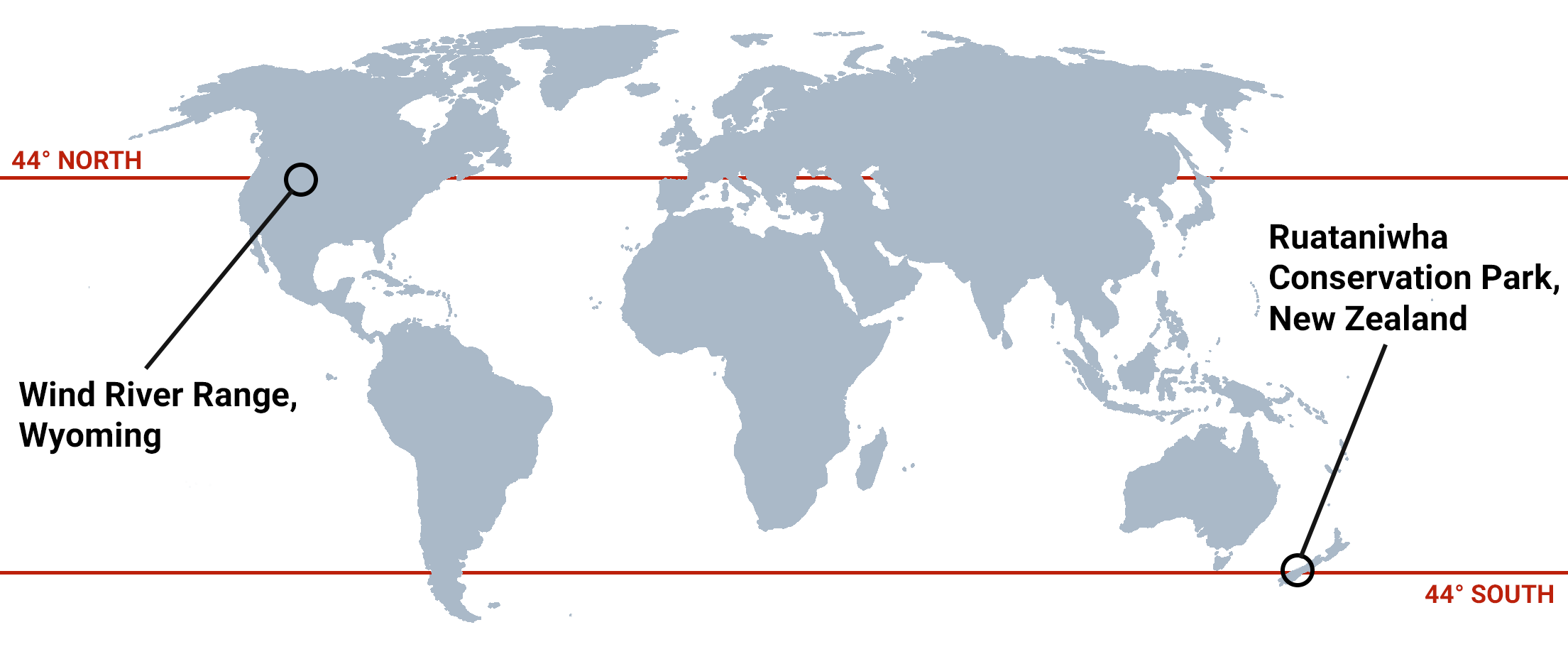
Collins’ work in Ohau will be a small part of her thesis and potentially a standalone paper, but it’s also part of the long line of work in New Zealand spearheaded by Denton. “We’re always picking up what the last person couldn’t quite finish,” she said.
If Collins’ boulders in New Zealand have similar ages to the ones she dated in the Northern Hemisphere, she will be adding to a growing body of knowledge that points to a globally synchronous ice age.
If ice ages are driven by summer insolation as Milanković claimed, it must be the case that they are anti-phased between the hemispheres as the seasons are. But Denton, Putnam, and their students have been amassing a collection of moraine dates that show the last ice age fluctuated and terminated around the same time in both hemispheres, directly contradicting Milanković’s claim of an asychronous ice age. Geochemist Wallace Smith Broecker, a close colleague of Denton, called this body of evidence, first observed by Mercer, the “fly in the Milanković ointment.”
If moraine dates show that Milanković is wrong about summer insolation’s role in driving ice ages, there must be a different explanation. Collins clarified that they aren’t completely discarding Milanković’s theory—certainly Earth’s orbits haven’t changed. But they are challenging them as the primary driver behind ice ages and abrupt climate change.
“It’s kind of two-fold,” Collins said. “Our chronologies don’t agree with the out-of-phase relationship plus that didn’t have a mechanism that made sense. We’re now saying, ‘Okay, global response. Here’s a mechanism that could produce that.’”
According to researchers from the University of Maine, orbital forcing does play a role, but a minor one, and they believe Milanković was focusing on the wrong hemisphere by fixating on the amount of insolation at the latitude 65 degrees north. They came up with a different hypothesis: Zealandia Switch, named for the massive, mostly-submerged continent where their research pointed the way to the new theory.

The Zealandia Switch hypothesis
Proving the last ice age was a global event is one thing; the real challenge is explaining the mechanism behind such a phenomenon. What atmospheric, oceanic, and planetary forces could cause abrupt climate change, like an ice age, on a global scale?
In 2021, Denton and six other researchers from the University of Maine, University of Arizona, and Columbia University published a paper in Quaternary Science Reviews, offering a hypothesis that reconciles the similarly aged boulders across hemispheres and provides an explanation for what could have caused global abrupt climate change, in the form of an end to an ice age.
Their theory is that orbital forcing plays a different role than what Milanković theorized. Rather than focusing on northern latitudes, the researchers looked to the Southern Hemisphere as the driver of ice ages.
Orbital forcing affects oceanic and atmospheric circulation in the tropical Pacific and Southern Ocean, which affects the Southern Hemisphere’s westerly winds, the strongest wind system on Earth. These westerlies regulate the exchange of carbon dioxide and heat between the ocean and atmosphere and are a key driver in the formation of ice ages, according to the authors of this paper.
Climate modeling by Joellen Russell, co-author of the study and professor at the University of Arizona, showed that the position of the westerlies could explain global climate change events. The shifting of the austral westerlies affects the strength of subtropical oceanic gyres—major ocean circulation systems—which influence how much energy is released from tropical waters. In Russell’s model, a shift of the westerlies towards the equator cools the entire world, whereas a shift of the westerlies towards the South Pole invigorated water circulation and did the opposite. Paleoclimatic records from the last ice age align with these observations as westerlies were further north during glaciation and further south during termination.
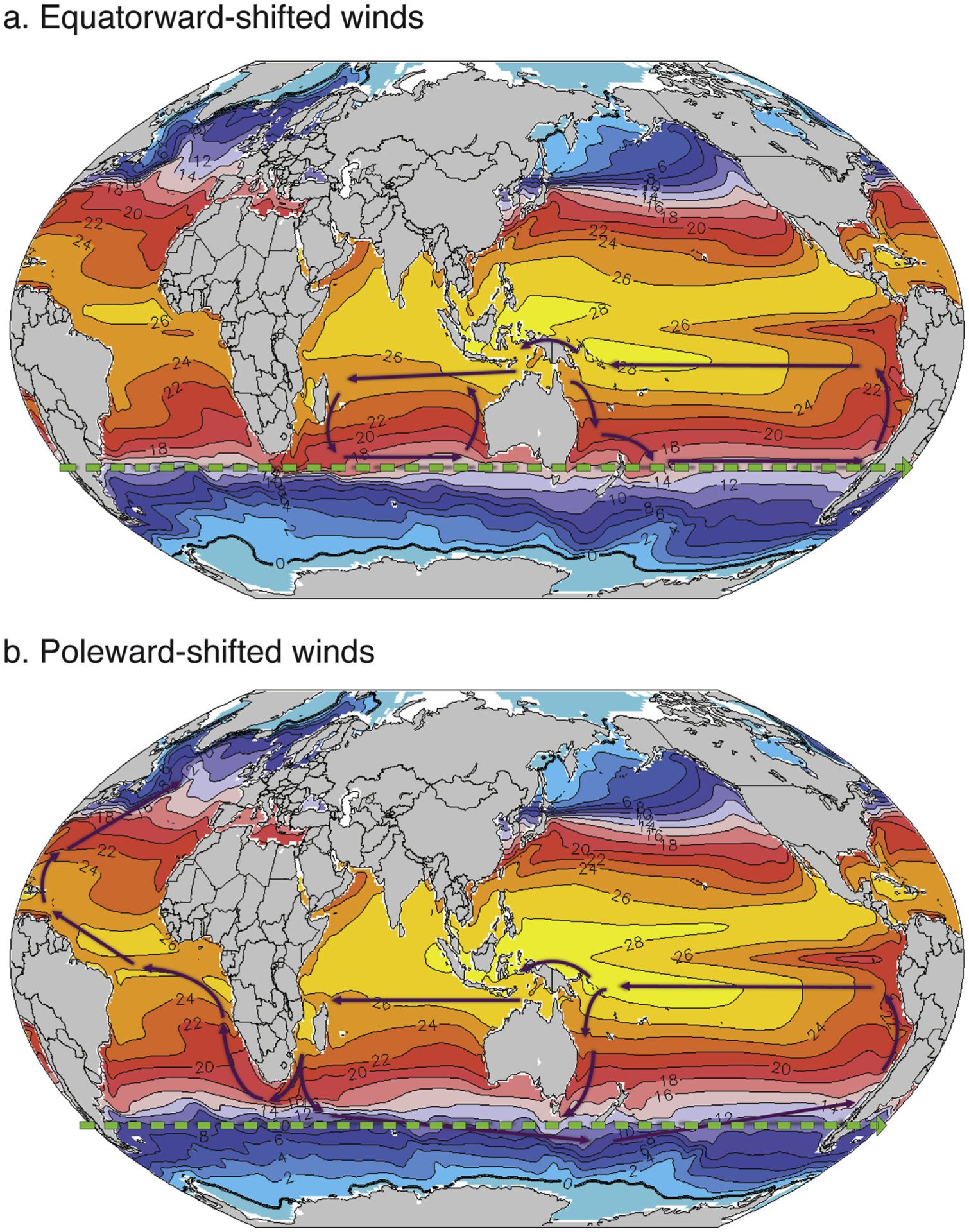
“Really what it comes down to is that, by the Zealandia Switch mechanism, anything that can alter the position of the westerlies, could have the potential for causing a global warming,” Putnam, a co-author of that paper, explained.
The Zealandia Switch hypothesis also emphasizes how abrupt climate change is anything but linear. As its name suggests, this mechanism acts like a switch and goes back and forth between two modes depending on the austral westerlies. The switch is “on” when the winds are in a poleward position and “off” when they are equatorward.
Russell suspected the westerlies would play a key role before they even began testing and modeling their theory, Putnam said. “The winds play a really important role in connecting the atmosphere to the deep ocean in terms of heat,” he said.
Milanković’s theory on ice ages remains the dominant one, but if the Zealandia Switch hypothesis is correct, scientists will have learned a mechanism behind climate change on a global scale. By looking to the past, they may be able to update predictive models and get a better understanding of what the future holds as the world battles global warming.
Zealandia Switch in today’s warming world
The hikers watching us, perplexed, as Roman drills into a large boulder, don’t realize the potential this research has for updating today’s climate models. It’s tiring work, both physically and mentally, as these researchers seek to overturn a long-held idea.
“It’s like a slow degradation,” Collins said, regarding the multiple weeks of fieldwork that tire out the body.
But why go through all of this physical work of drilling and hauling rocks all day in pelting rain, sweltering heat, and whipping winds? Part of it is the inherent love for nature the scientists feel, as well as the satisfaction of resolving the conundrum of global climate events.
“I need to be out there in the wild, the messy, messy wild,” Collins said.
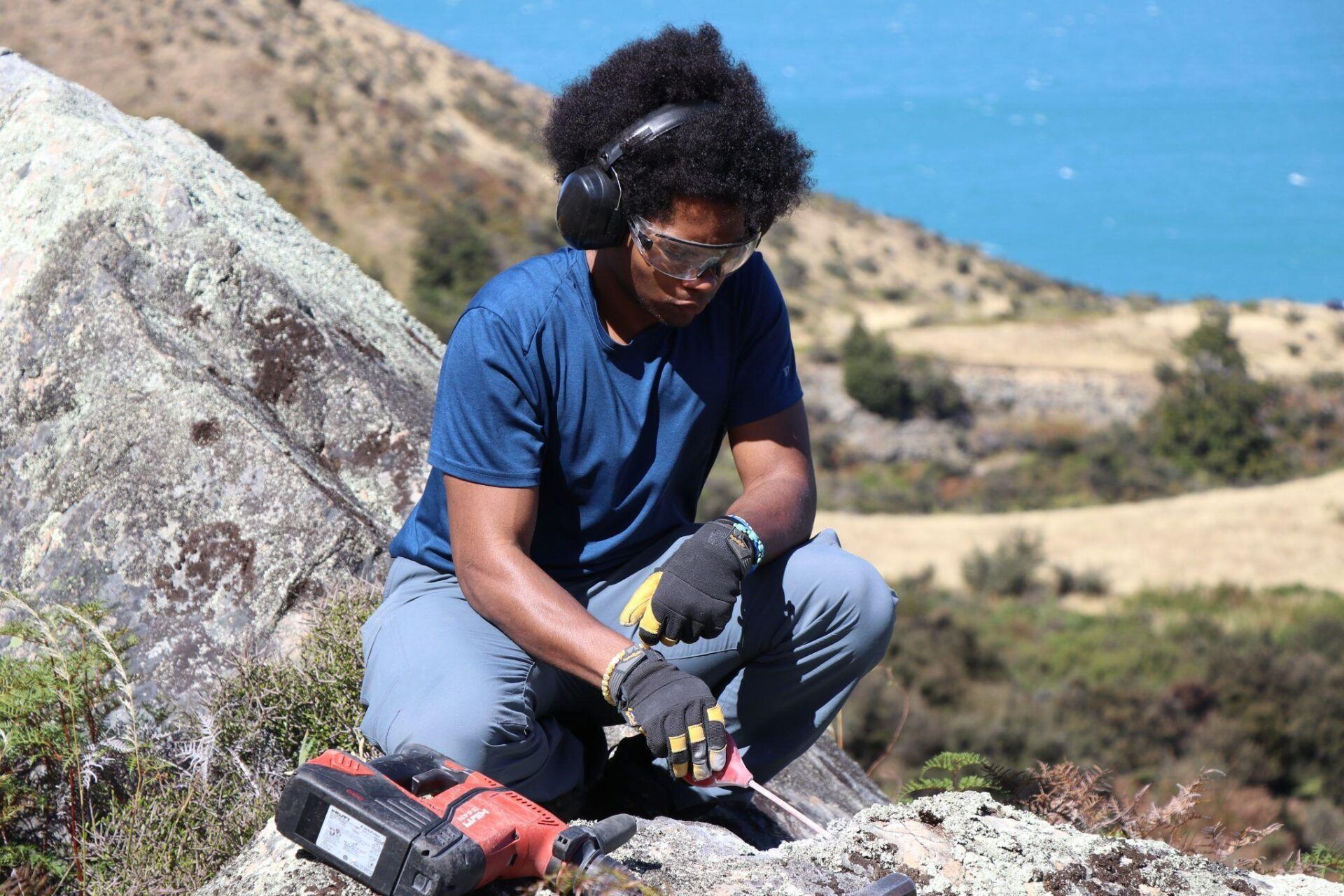
But there’s also a lot at stake within these small chunks of rock.
The world is treading into unknown territory and things we once understood, like El Niño and La Niña, are behaving in unpredictable ways. To understand what will happen in the future, paleoclimatologists are looking to the past, and the decades of research done on the Southern Hemisphere could inform much-needed climate models.
“In all the models, there’s what they call an equatorward bias towards the westerlies, which is important,” Putnam said. “That could be as important as determining whether a model is capable of simulating an El Niño or not.”
If the westerlies are as important as some researchers say they are, models would need to be updated to take the westerlies into account. The researchers involved in the Zealandia Switch research believe we could see this mechanism in play today as increased carbon dioxide in the atmosphere cause the westerlies to contract and move poleward, strengthening and accelerating as a figure skater would during a tuck spin. If the Zealandia Switch hypothesis is correct, pollution from human activities is reinvigorating the ocean-atmosphere interactions that ended the last ice age, which was a case of abrupt global warming.
“The polar shift that’s occurring now is similar to the polar shift that happened at the end of the termination, except we are driving this shift with our greenhouse gas emissions,” Russell explained.
Putnam said we may be heading into a world where warming from human forces is superimposed onto the warming interglacial mode of the Zealandia Switch. The paper calls this a “superinterglacial mode,” and a possible consequence of this is accelerated warming. Human activity could even be acting as a catalyst that indefinitely keeps the switch “on” in a poleward position.
Michael Kaplan, coauthor of the study and professor at Columbia University, said a superinterglacial mode could mean a longer or warmer interglacial period, but ultimately, it’s still a mystery.
When it comes to abrupt climate change, which happens in a span of years or decades, a climate system clings to its current state until it crosses a threshold and is forced into a new one. The warming that terminated the Last Glacial Period is an example of this and continues to be an important reference for what could happen to the planet as we make our way across that threshold. During the termination, a southward shift in the westerlies was accompanied by the release of carbon dioxide from the Southern Ocean, which may have locked the climate system in a warm interglacial mode.
Former NASA scientist James Hansen of Columbia University and several colleagues foresee a largely ice-free Earth and immense inundation if carbon dioxide levels cross the threshold of 450 parts per million. Current levels have topped 420 parts per million and are continuing to climb at roughly 3 ppm per year, meaning the world could reach or cross that threshold in just a decade.
“I think the amount of carbon dioxide we put in the atmosphere already means that the Greenland ice sheet is doomed and that at a bare minimum, most of the ice sheet in Antarctica will over the next thousands of years disappear,” Russell said.
The fact that humans have interfered with natural glacial cycles is arguably irrelevant as the next ice age would not have happened for tens of thousands of years, but it does mean higher sea levels, longer summers, and more natural disasters, according to Russell.
A new understanding
While the Zealandia Switch sounds “revolutionary” as Roman once called it, Milanković’s theory on ice ages continues to dominate paleoclimate circles. The Zealandia Switch hypothesis is still relatively new in the grand scheme of science, but in the last three years, the paper has been one of the most cited one in the journal.
“It’s really kind of establishing a new framework,” Collins said. “It’s powerful stuff.”
Together, we make the world safer.
The Bulletin elevates expert voices above the noise. But as an independent nonprofit organization, our operations depend on the support of readers like you. Help us continue to deliver quality journalism that holds leaders accountable. Your support of our work at any level is important. In return, we promise our coverage will be understandable, influential, vigilant, solution-oriented, and fair-minded. Together we can make a difference.
Keywords: climate change, climate science, glacial geology, glaciers, ice ages
Topics: Climate Change









Please provide a link to the paper. Thanks.
“If ice ages are driven by summer insolation as Milanković claimed, it must be the case that they are anti-phased between the hemispheres as the seasons are.” That’s oversimplified, Land and ocean climate responses are different; heat into the oceans gets transported by evaporation and current flow; land doesn’t flow, and the water available for evaporation is limited, Ignoring the imbalance between hemispheres in percent land mass(as well as the asymmetric transport of heat by the AMOC) is a crucial oversimplification. “Everything should be made as simple as possible, but not simpler” The mechanism is also not a switch, but… Read more »